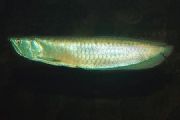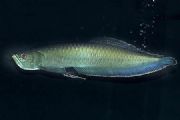Article categories:
Select a category below to view articles on each subject.
Search
Enter your keyword/s below to search :

Fish delivered straight to your door from Wildwoods
Hundreds of Species available today…
TFF Mailing List
Join the TFF mailing list today and we will email you with latest offers, news items and more.
Arowanas: the legendary dragonfishes
The family Osteoglossidae, commonly called arowanas, includes ten species of large, primitive fish distributed right across the tropics. Because they cannot tolerate salt water, the existence of such closely related fishes across South America, Africa, Asia, and Australia mystified biologist for years, until continental drift was understood. The simple answer is that these fish are among the most ancient known to science, and first appeared when these continents were still joined together, during the Age of the Dinosaurs! In fact, recent genetic studies have dated the separation of the South American species from the African ones to no less than 220 million years ago! Arowanas are true "living fossils" like the coelacanth and lungfish, which is one reason why they are much studied by biologists.
For the aquarist, the science may be interesting but what matters is that these fish are among the most spectacular of all freshwater fish. Besides sheer size and beauty, these fish also have a huge amount of presence, that difficult to define thing that some fish have, but most do not. In Asia particularly, the resemblance of the arowana to an oriental dragon has made these fish prized symbols of prosperity and good luck. There is a huge demand for these "dragonfish", mostly species of Scleropages, among Chinese communities in particular, with consequently high prices for the most attractive specimens. Show-winning Asian arowanas have been known to change hands for more than £300,000! Because they are endangered across most of their natural range, the Asian arowanas offered for sale are all farm-raised and can only be legally sold if accompanied by the supporting CITES certification. Such fish are also micro-chipped, ensuring that each fish is matched to its correct certificate. A new Aqualog book, Aqualog - Asian Arowana, reviews these remarkable fish, their husbandry, and their popularity in great depth and is worth look at if Asian arowanas interest you.
Not all arowanas are that expensive though, and the South American species in particularly can be obtained for the same sorts of prices as large catfish and cichlids. Even so, these aren't fish for casual aquarists, as they do grow large and cannot be considered hardy in the sense of being tolerant of overcrowded aquaria with poor water quality. As ever, it pays to do your research and plan ahead.
Basic care and requirements
Arowana care can be summarised by their need for very large aquaria, excellent water quality, peaceful tankmates too large to be eaten, and a balanced diet. Starting with the aquarium, adults of even the smallest species will need a tank of around 200 gallons capacity. Of course juveniles can be kept in smaller tanks, but these fish do grow fairly quickly. An oft-quoted rule of thumb is to expect a juvenile arowana to grow 1 to 1.5 inches per month until it is about two-thirds grown, after which growth rate will slow down. In other words, a cute tiddler 4 inches long could be almost two feet long a year later!
Water quality is also critically important; as with any large predator, these fish pump out a lot of nitrogenous waste, and this needs to be dealt with quickly. A large biological filter is essential, and in most cases one or more external canister filters will be required. In terms of water chemistry, arowanas come from environments with soft and acidic water, and that should be replicated if possible. That said, most seem to adapt well to hard and alkaline water. The addition of blackwater extract or careful use of peat in the filter is also recommended.
All arowanas are territorial to some degree, and some are downright aggressive. The South American species, Osteoglossum spp. and the African arowana, Heterotis niloticus, are generally the most tolerant and can be kept with anything peaceful that is too big to be considered food. On the other hand, these arowanas are very waspish towards their own species, though South American arowanas can be kept in groups in really big (i.e., public) aquaria. The Asian and Australian arowanas, Scleropages spp., are less tolerant of tankmates and some species, in particular Scleropages jardinii, will harrass anything else in the tank with them. Tankmates for these arowanas need to be robust and not easily bullied.
Most arowanas are predators. The exception is the African arowana, which is mostly a plankton feeder but also sifts sand and mud to extract small invertebrates such as worms. The predatory arowanas feed primarily on small animals at the surface of the water or above it; many species are adept jumpers and will take insects and spiders from overhanging trees. While arowanas will eat small fish, these aren't recommended because of the risk of introducing parasites. The best diet for the predatory arowanas is a mix of commercially prepared floating pellets and supplemental feedings of frozen or live invertebrates such as insects and shrimps. Over-feeding is a particular problem with arowanas, and they will certainly accept more food than is good for them.
South American arowanas
There are three South American arowanas, Arapaima gigas, the huge arapaima, and two smaller species, Osteoglossum bicirrhosum and Osteoglossum ferreirai. At over 9 feet in length when mature, the arapaima isn't an aquarium fish at all, but the two smaller species are quite commonly traded. Osteoglossum bicirrhosum is known as the silver arowana and gets to around three feet in length; the black arowana Osteoglossum ferreirai is slightly smaller. Both are elongate, laterally compressed fish with large scales and distinctive "feelers" or barbels at the front. These barbels are attached to the lower jaw. Farmed and wild caught specimens are offered for sale. Of the two, the silver arowana is considered to be the easiest to keep, being less picky about water chemistry. Juvenile black arowana are attractive though, with a broad black band running from behind the gills to the tip of the tail. As these fish mature, this colouration is lost, and adult fish are silvery with a distinct blue sheen. Silver arowanas are greenish-silver.
African arowanas
The African arowana Heterotis niloticus is hardly every sold. It is a fairly drab fish, with a greyish-brown body and a terminal, rather than upwards-pointing, mouth. Wild specimens get to about three feet in length, though aquarium specimens are usually smaller. They are mostly filter feeders and substrate sifters. Though very hardy and easy to keep, their lack of bright colours probably accounts for their rarity in the hobby.
Asian arowanas
Asian arowanas are similar to South American arowanas in basic shape, but are notably less elongate and much more stocky. They also have bigger scales and brighter colours. Adults specimens are about two to three feet in length. They are basically hardy fish, though sensitive to poor filtration, and provided they are housed in suitable quarters generally do very well. Four species are known, Scleropages aureus, Scleropages formosus,Scleropages legendrei, and Scleropages macrocephalus; however, it is more common to see these fish sold under a variety of trade names. The super red and chili red arowanas, for example, are varieties of Scleropages legendrei, while the green and gold crossback arowanas are forms of Scleropages formosus. Some of these varieties are naturally occuring, while others have been artificially bred. In general, the silver and green fishes tend to be the less expensive, while those with red and purple colouration tend to be much more costly. As with any farm-raised fish, quality comes with a price tag, and show-quality fish are very expensive; in this sense the trade in Asian arowanas is comparable to that in top-quality koi carp.
Australian arowanas
There are two species of arowana in Australia, Sceleropages jardinii and Sceleropages leichardti. In appearance and care they are similar to the Asian species, though as noted above Sceleropages leichardti is a pretty aggressive, intolerant animal. Neither species is common in the aquarium trade. They are of scientific interest because they are two of only three primary freshwater fish native to Australia (the third is the native lungfish). All the other fishes in Australia's rivers and lakes, including the rainbowfish and catfish, are descended from marine fish groups.
This article cannot be reproduced without the permission of Tropicalfishfinder.
Other fish articles:
Other fish articles you may be interested in are listed below, click an article for full details.
-
FISH ARTICLE
-
FISH ARTICLE
-
FISH ARTICLE
-
FISH ARTICLE









